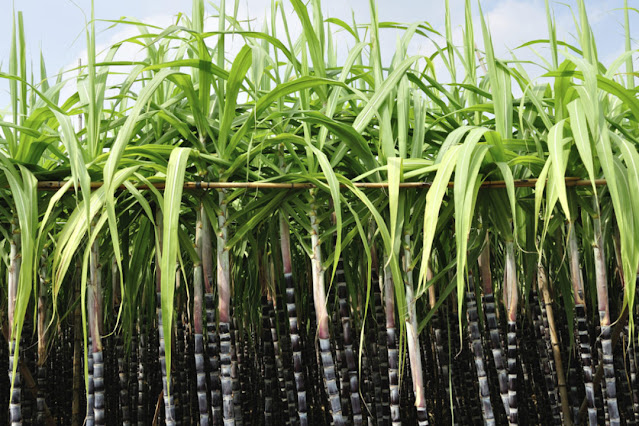Sugarcane/Ganna - Health benefits, application, chemical constituents, side effects and many more
Sugarcane/Ganna
Sugarcane (Saccharum officinarum Linn.) is an important perennial grass of Poaceae family, indigenous to tropical South Asia and Southeast Asia. It is cultivated worldwide due to the economical and medicinal value of its high yielding products. Sugarcane juice is well known as a raw material for the production of refined sugar and its wax is considered as a potential substitute for the expensive carnauba wax, which is of cosmetic and pharmaceutical interest. Refined sugar is the primary product of sugarcane juice, but during its processing, various other valuable products are also obtained in an unrefined form, such as, brown sugar, molasses, and jaggery. Sugarcane juice is widely used in India in the treatment of jaundice, hemorrhage, dysuria, anuria, and other urinary diseases.
It has different names in different languages such as Hindi name(Ganna, Eekh, Ikha), English name(Sugarcane), Marathi name(O..........................read more
Phytochemical constituents
- Vitamins : B6, B9, C
- Minerals : Calcium, Iron, Magnesium, Phosphorus, Potassium, Sodium, zinc
- The phytochemistry of sugarcane wax (obtained from the leaves and stalks of sugarcane), leaves, juice, and its products has revealed the presence of various fatty acid, alcohol, phytosterols, higher terpenoids, flavonoids, -O- and -C-glycosides, and phenolic acids.
- Policosanols and D-003 along with some steroids and terpenoids have also been identified and isolated from sugarcane wax. Policosanols are a mixture of long chain primary aliphatic alcohols (1 - 8) ranging from 2.5 - 80%. Octacosanol (1) constitutes 50 - 80% of the total policosanoles. Other major pharmacologically active components of sugarcane wax are long chain aliphatic fatty acids (9 - 18) present at lower concentrations. The mixture of these acids is known as D-003 Although fatty acid and fatty alcohol are reported as major constituents various phytosterols (19 - 22), steroids (23 - 28), and higher terpenoids (29 - 30) have also been reported in sugarcane wax.
- Sugarcane is comprises of 70 - 75% water, 13 - 15% sucrose, and 10 - 15% fib..........................read more
Best time to take sugar cane juice
Take sugar cane juice in the afternoon, when Pitta Dosha is predomi..........................read more
Properties and Benefits
- Rasa (Taste) – Madhura (Sweet)
- Guna (Qualities) – Guru (Heavy), Snigdha (Slimy)
- Taste conversation after digestion – Madhura (Sweet)
- Veerya (Potency) – Sheetala (Cold)
- Effects on Tridosha – Reduces vitiated vata & pitta dosha
- Explore more about Tridosha(vata-Kapha-Pitta)
- Jeevana – enlivening
- Brimhana – improves weight
- Vrushya – aphrodisiac, improves vigor
- Krumiprada – can cause or worsen intestinal worm infestation
- Mutraprada – Mutrala – diuretic, improves urine flow
- Sara – induces mobility, causes diarrhoea, purgation, relieves consti..........................read more
Uses, Remedies, Benefits and Application
1) Sugarcane juice in a dose of 100-150 ml is consumed to control nausea and vomiting.
2) Sugarcane wax(whitish to dark-yellowish powdery deposit on the surface of stalks and leaves) is used as a commercial source of long chain fatty alcohols, acids, esters, aldehydes, and ketones.
- The amount of wax in sugarcane ranges between 0.1 and 0.3%, depending upon its variety.
3) Regular intake of sugarcane juice will improve the quality of semen and increase the quantity of breast milk in lactating women.
4) Nutrients found in sugarcane are beneficial for inner organ functioning, including the kidneys, heart and brain.
5) Intake of sugarcane juice in a dose of 100-200 ml will improve the urine output and hence used in conditions of difficulty in micturition, burning micturition and in renal calculi.
6) Fresh sugarcane juice is consumed to reduce thirst, burning sensation of the body and provide instant energy.
7) Deficiency of nutrients in the body can easilybe recovered by including sugarcane juice in our diet.
8) Sugarcane juice helps in proper functioning of digestive system and prevents stomach infections.
9) Mixture of Sesame oil cakes, Vidanga (Embelia ribes), sugar cane juice and cow dung is sprinkled to the root of a plant. This practice enables flowering of the plant in all the seasons.
Click here to explore more about Sesame seed
10) Intake of sugarcane juice is beneficial for persons suffering from constipation, jaundice and anaemia.
11) Sugarcane juice is good for burl..........................read more
Side effects
- It is not ideal in high Kapha disord..........................read more
If you want to give more suggestion in this, then comment us, we will replay your comment.
If you like this post, then share it and follow us on Instagram (@healthyeats793) and many thanks for coming to our site Healthy eats
keep visiting
Follow us
3) Facebook
4) Pinterest
🙏🙏Subscribe and share for latest updates 🙏🙏
More posts from our site
- Click here for more information about Tamarind
- Click here for more information about Nutmeg (Jaiphal)
- Click here for more information about Viruddha aahra
- Click here for more information about Jambul (java phalam)
- Click here for more information about Marking nut (bibba)
- Click here for more Home remedies of Nirgundi
- Click here for more information about saffron
- Click here for more information about Elephant foot/Yam
- Click here for more information about Watermelon 🍉🍉
- Click here for more information about Jackfruit/phanus
- Click here for more information about summer care ☀️
Refrence
- Charaka Samhita
- Pharmacogn Rev. 2015 Jan-Jun; 9(17): 45–54. PMCID: PMC4441162
- Trop Plant Biol. 2011; 4(1): 62–89. PMCID: PMC3075403
- Sushruta samhita
- Molecules. 2019 Mar; 24(5): 934. PMCID: PMC6429268
- Plant Foods Hum Nutr. 2006 Dec;61(4):187-92.
- fJWBK235-Kole k0701 April 25, 2008
- Pharmacognosy Reviews | January-June 2015 | Vol 9 | Issue 17
- NCBI
- PUBMED
- Local tradition and knowledge
- Bhavaprakasha Nighantu
- Dhanawantari Nighantu

.png)




Comments
Post a Comment